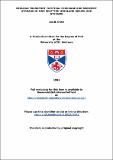Bedload transport, vertical exchange and sediment storage in two Scottish Highland gravel bed streams
Abstract
High recovery magnetic tracing techniques have been utilised to record the 3-
dimensional downstream transport of individual clasts within two Scottish Highland
gravel-bed streams over a period of 16 months. The results provide the basis for a
conceptual model of bedload transport and storage involving the interaction of multiple
variables.
Above a threshold level of discharge, determined by local morphology and
sedimentology, flow (in terms of magnitude and duration) remains the principal control of
transport parameters (occurrence, vertical exchange, depth of scour, and transport
distance). Three phases of transport based on increasing discharge are identified; discrete
surficial transport, shallow exchange transport and deep exchange transport. Variations in
apparent flow and transport relationships are explored in relation to individual clast
characteristics and contrasts in bed sedimentology between streams.
The results suggest a large degree of equal mobility in terms of clast size. However,
a tendency exists for material approximating the median bed surface grain size to show
maximum mobility, indicating the importance of hiding effects on gravel entrainment. In
terms of clast form, flattened shapes are the least mobile. This reflects a greater stability at
entrainment, and increased occurrence of capping, for clasts with small c/b axial ratios. A
high percentage of angular material leads to bed strengthening through interlock.
Two clast location variables, morphological position (bar, riffle, pool or
undifferentiated channel), and burial state (top, within or buried), are considered in relation
to the occurrence and distance of transport. The importance of temporary bar and subsurface
storage is highlighted. Residence periods for bed material in both such locations are
determined principally by flow conditions, particularly peak discharge. Powerful floods are
associated with increased submergence of high bars, and erosion to great depth. Material
deposited in high bar positions, or at the base of deep scour zones, is effectively locked in
storage until the next flow of equal or greater discharge.
Although the model presented is based on work at just two sites, it is suggested that
the range of morphological and sedimentological conditions encountered make the general
principles applicable across a broad range of similar environments. Given consideration of
the variables discussed, a specific variation of the model should apply in most river
reaches.
Type
Thesis, PhD Doctor of Philosophy
Collections
Items in the St Andrews Research Repository are protected by copyright, with all rights reserved, unless otherwise indicated.

